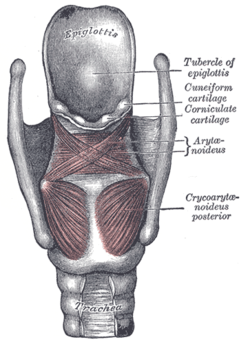Epiglottis
| Epiglottis | |
|---|---|
 View of the larynx from behind. The epiglottis is the structure at the top of the image. | |
| Details | |
| Precursor | Fourth pharyngeal arch[1] |
| Function | Prevent food from entering the respiratory tract |
| Identifiers | |
| Latin | epiglottis |
| MeSH | D004825 |
| TA98 | A06.2.07.001 |
| TA2 | 3190 |
| FMA | 55130 |
| Anatomical terminology | |
The epiglottis (pl.: epiglottises or epiglottides) is a leaf-shaped flap in the throat that prevents food and water from entering the trachea and the lungs. It stays open during breathing, allowing air into the larynx. During swallowing, it closes to prevent aspiration of food into the lungs, forcing the swallowed liquids or food to go along the esophagus toward the stomach instead. It is thus the valve that diverts passage to either the trachea or the esophagus.
The epiglottis is made of elastic cartilage covered with a mucous membrane, attached to the entrance of the larynx. It projects upwards and backwards behind the tongue and the hyoid bone.
The epiglottis may be inflamed in a condition called epiglottitis, which is most commonly due to the vaccine-preventable bacterium Haemophilus influenzae. Dysfunction may cause the inhalation of food, called aspiration, which may lead to pneumonia or airway obstruction. The epiglottis is also an important landmark for intubation.
The epiglottis has been identified as early as Aristotle, and gets its name from being above the glottis (epi- + glottis).
Structure

The epiglottis sits at the entrance of the
The epiglottis originates at the entrance of the larynx, and is attached to the hyoid bone. From there, it projects upwards and backwards behind the tongue.[3] The space between the epiglottis and the tongue is called the vallecula.[3]
Microanatomy
The epiglottis has two surfaces; a forward-facing
Development
The epiglottis arises from the fourth pharyngeal arch. It can be seen as a distinct structure later than the other cartilage of the pharynx, visible around the fifth month of development.[1] The position of the epiglottis also changes with ageing. In infants, it touches the soft palate, whereas in adults, its position is lower.[3]
Variation

A high-rising epiglottis is a normal anatomical variation, visible during an examination of the mouth. It does not cause any serious problem apart from maybe a mild sensation of a foreign body in the throat. It is seen more often in children than adults and does not need any medical or surgical intervention.[5] The front surface of the epiglottis is occasionally notched.[2]
Function
The epiglottis is normally pointed upward during
Swallowing
During swallowing, the epiglottis bends backwards, folding over the entrance to the trachea, and preventing food from going into it.[2] The folding backwards is a complex movement the causes of which are not completely understood.[2] It is likely that during swallowing the hyoid bone and the larynx move upwards and forwards, which increases passive pressure from the back of the tongue; because the aryepiglottic muscles contract; because of the passive weight of the food pushing down; and because of contraction of laryngeal and because of contraction of thyroarytenoid muscles.[2] The consequence of this is that during swallowing the bent epiglottis blocks off the trachea, preventing food from going into it; food instead travels down the esophagus, which is behind it.[3]
Speech sounds
In many languages, the epiglottis is not essential for producing sounds.[2] In some languages, the epiglottis is used to produce epiglottal consonant speech sounds, though this sound-type is rather rare.[7]
Clinical significance
Inflammation
Inflammation of the epiglottis is known as epiglottitis. Epiglottitis is mainly caused by
The incidence of epiglottitis has decreased significantly in countries where vaccination against Haemophilus influenzae is administered.[9][10]
Aspiration
When food or other objects travel down the respiratory tract rather than down the esophagus to the stomach, this is called aspiration. This can lead to the obstruction of airways, inflammation of lung tissue, and aspiration pneumonia; and in the long term, atelectasis and bronchiectasis.[3] One reason aspiration can occur is because of failure of the epiglottis to close completely.[2][3]
If food or liquid enters the airway due to the epiglottis failing to close properly, throat-clearing or a cough reflex may occur to protect the respiratory system and expel material from the airway.[3][11] Where there is impairment in laryngeal vestibule sensation, silent aspiration (entry of material to the airway that does not result in a cough reflex) may occur.[3][12]
Other
The epiglottis and vallecula are important anatomical landmarks in intubation.[13] Abnormal positioning of the epiglottis is a rare cause of obstructive sleep apnoea.[14]
Other animals
The epiglottis is present in
History
The epiglottis was noted by
Additional images
-
Cross-section of the larynx, with structures including the epiglottis labelled.
-
Cross-section of the larynx of a horse. The epiglottis here is shown as '2'.
-
Structures of the larynx as viewed during laryngoscopy. The leaf-like epiglottis is shown as number '3'. Other structures: 1=vocal folds, 2=vestibular fold, 3=epiglottis, 4=plica aryepiglottica, 5=arytenoid cartilage, 6=sinus piriformis, 7=dorsum of the tongue
See also
- Epiglottal consonant
- Epiglotto-pharyngeal consonant
- Pharyngeal consonant
References
- ^ ISBN 9780443068119.
- ^ )
- ^ PMID 18940636.
- ^ ISBN 9780128029008
- PMID 17823468.
- PMID 10029195.
- ISBN 9781444335262
- ISBN 978-0-7020-3084-0.
- S2CID 33540359.
- PMID 24814584.
- PMID 16816346.
- S2CID 24880995.
- ISBN 9780781762755.
- S2CID 23615987.
- ^ ISBN 9781408836217.
- ISBN 9780080919935.
- ^ ]
- ISBN 9780123809209.
- PMID 21601814.
- ISBN 9780128029190.
- ISBN 9781464964770.
- S2CID 10234119.
- ^ Harper, Douglas. "epiglottis | Origin and meaning of epiglottis by Online Etymology Dictionary". www.etymonline.com. Retrieved 26 October 2019.
External links
- lesson11 at The Anatomy Lesson by Wesley Norman (Georgetown University) (larynxsagsect)
- Where is the Epiglottis? Archived 2022-05-18 at the Wayback Machine at Study Sciences



